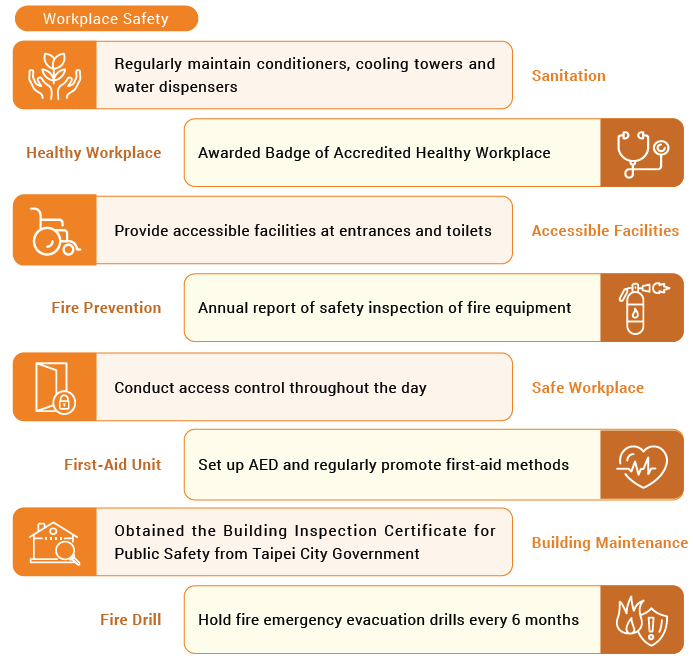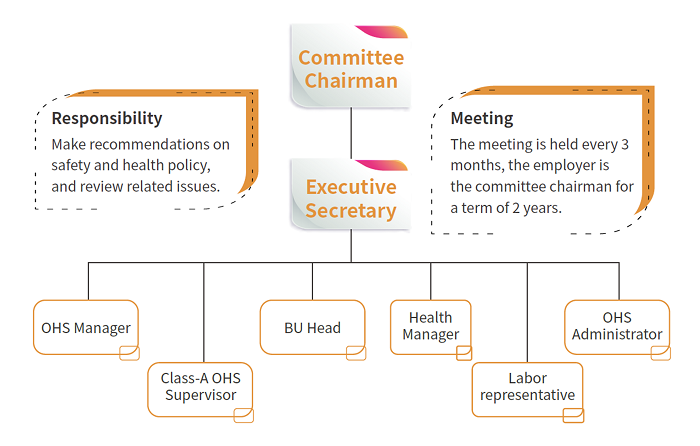Occupational Safety and Health
Occupational Health and Safety Management System
Based on the “Occupational Safety and Health Act” and other related laws and regulations, SYSTEX has formulated the “Safety and Health Work Rules”, which applies to workers in SYSTEX and its affiliates and non-employees, including security guards, cleaning workers and electrical & mechanical workers. SYSTEX also set up an “Occupational Safety and Health Committee”, attended by OHS managers and the supervisors, BU heads and labor representatives, to discuss OHS-related issues in order to maintain workplace safety. In 2023, SYSTEX continuously conducts audits and maintains the validity of ISO 45001. (Valid period: 2021/12/22-2024/12/21)
Occupational Health and Safety, Environment and Energy Policy and Declaration
SYSTEX Occupational Health and Safety, Environment and Energy Policy and Declaration
|
|
SYSTEX is an IT service company, and committed to promoting occupational safety and health, improving environment and energy management, to maintain workplace safety as a priority. In response to the government’s goals, SYSTEX continuously improves environmental protection actions to make better efforts for a safer and healthier environment. SYSTEX promises:
|
Hazard Identification, Risk Assessment, and Incident Investigation
SYSTEX has set up “Hazard Identification Management Procedures” to evaluate the corresponding risks and opportunities and review the management effectiveness. SYSTEX regularly conducts hazard identification, evaluates “work stress” as a major hazardous risk item in 2023, and then the health manager formulates an “Abnormal workload prevention plan” to reduce risk. In accordance with the OHS Act, all workers are free to remove themselves from life-threatening situation and are exempt from disciplinary action. SYSTEX has set up the “Emergency Response Management Procedures” to regulate the investigation and prevention of accidents. After the accident, the unit where the accident occurred reviewed and reported the cause of the accident; in addition, the OHS management unit may form an accident investigation team depending on the severity of the accident.
Monitoring Plan through Occupational Health and Safety Management System
| Monitoring Items | Approach | Frequency |
| Disabling Injury Frequency Rate (FR) | Internal | Monthly |
| Disabling Injury Severity Rate (SR) | Internal | Monthly |
| Frequency-Severity Indicator (FSI) | Internal | Monthly |
| Employee Health Check Rate (%) | Internal | Annually |
| Reporting of work-related injury | Internal | Monthly |
| Health Promotion Efficiency (%) | Internal | Quarterly |
| Emergency Drill Implementation Rate (%) | Internal | Annually |
| Internal audits for ISO 45001 | Internal | Annually |
| Management review meetings of ISO 45001 | Internal | Annually |
| External audits for ISO 45001 | Outsourcing | Annually |
Workplace Safety

Occupational Health and Safety Committee

Committee Composition, Authority and Communication
| Composition |
|
| Authority |
|
| Evaluation Mechanism |
|
| Communication or Negotiation |
|
Occupational Health and Safety Training
For establishing the occupational safety and health awareness, SYSTEX arranges occupational safety and health-related training for new-hires, and conducts demonstrations of first-aid facilities to all employees irregularly. In addition, SYSTEX assigns relevant personnel to participate in OHS training, including the certificate of “Class-A OHS Supervisor”, “Class-B OHS Technician Certificate”, and other professional training. Meanwhile, SYSTEX also conducts a fire drill every 3 months to enhance disaster prevention awareness for all employees.
| 01 | OHS Training for New-hires | |
|
||
2023 OHS Training for New-hires
| 02 | OHS Training for Professionals | |
|
||
2023 OHS Training for Professionals
| 03 | Fire Drills | |
|
||
2023 Fire Drills
Work-Related Injuries
In 2023, a total of 1 work-related injuries, including 1 female and 0 males. The rate of recordable work-related injuries was 0 for males, 0.13 for females and for a total of 0.13. The injury types are all fractures or abrasions. The injured employees in each case have been followed up by health managers and recovered within 6 months.
2023 Work-related Injuries Statistics (by Gender, excluding commuting accidents)
| Male | Female | Total | |
| Total employees of work-related injury (people) | 0 | 1 | 1 |
| Total employees of high-consequence work-related injuries (excluding fatalities) (people) | 0 | 0 | 0 |
| Total employees of fatalities of work-related injuries (people) | 0 | 0 | 0 |
| Rate of work-related injury (%) | 0.00 | 0.13 | 0.13 |
| Rate of employees of high-consequence work-related injuries (excluding fatalities) (%) | 0 | 0 | 0 |
| Rate of employees of fatalities of work-related injuries (%) | 0 | 0 | 0 |
Note:
1.Total hours worked = 7,869,881 (Number of days worked * 8 hours * number of employee)
2.All work-related injuries in 2022 are in the workplace, business commuting or clients’ offices, and the types of injuries are fractures and bruises. Each injured employee has been followed up by the “Health Manager” and recovered within 6 months.
3.High-consequence work-related injuries refer to the fatalities of work-related injuries or the failure of the injured employee to fully recover to pre-injury health status within 6 months.
4.Rate of work-related injury = (Number of work-related injuries / total hours worked) * 1,000,000.
5.Rate of fatalities of work-related injuries = (Number of fatalities of work-related injuries / total hours worked) * 1,000,000.
3-Year Work-related Injuries Statistics (excluding commuting accidents)
| 2021 | 2022 | 2023 | |
| Total employees of work-related injury (people) | 5 | 9 | 1 |
| Total hours worked (hours) | 7,492,000 | 7,734,000 | 7,869,881 |
| Rate of work-related injury (%) | 0.67 | 1.16 | 0.13 |
Note:
1.Total hours worked = Number of days worked * 8 hours * number of employee
2.All work-related injuries in 2021, 2022 and 2023 are in the workplace, business commuting or clients’ offices, and the types of injuries are fractures and bruises. Each injured employee has been followed up by the “Health Manager” and recovered within 6 months.
3.Rate of work-related injury = (Number of work-related injuries / total hours worked) * 1,000,000.
3-Year Absentee Statistics
| 2021 | 2022 | 2023 | |
| Total employees absentee days (days) | 3,112.4 | 4,892.1 | 5,812.6 |
| Total days worked (days) | 936,500 | 966,750 | 983,735 |
| Absentee rate (%) | 0.33 | 0.51 | 0.59 |
Note:
1.Total number of absentee days is due to absenteeism of any kind, not only as a result of work-related injury or disease. This includes individual sick days due to minor illnesses (e.g. the common cold, fevers, and influenza) as well as personal days taken for undisclosed reasons. It does not include scheduled or permitted absenteeism such as holidays, study time, maternity or paternity leave, etc.
2.Total days worked = Number of days worked * number of employee
3.Absentee rate = (Total number of absentee days / total days worked) * 100%.

